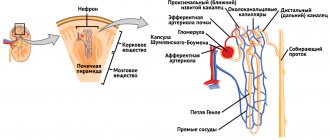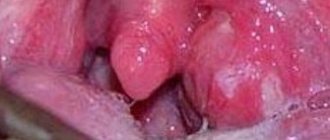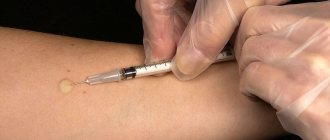Causes
Kidney abscess develops under the influence of many factors.
Necrosis is explained by ischemia and further infection of the kidney. When a purulent cavity occurs, the inflammatory process turns into an abscess. Doctors identify the following causes of an abscess on the kidney:
- The most common is purulent pyelonephritis or inflammation of the kidney. Small purulent cavities that form during pyelonephritis merge into one.
- The occurrence of pathology can be triggered by an infectious lesion of the organ.
- Urogenic pyelonephritis is a provoking factor for abscess of the renal system. Pathogenic bacteria infect the organ through the renal papilla.
- The disease in some cases occurs due to urolithiasis or during the removal of stones from the urethra.
- Abscesses of the metastatic variety are possible. Infectious cells enter the internal organ through the circulatory system from the pulmonary or cardiac system.
- There are cases where the cause of the disease was a knife wound to the kidney.
In most cases, the disease affects only one kidney; the bilateral nature of the disease is much less common.
A kidney abscess can also be caused by bacteria that enter the body through the urethra.
Staphylococcus
Risk factors
For each disease, there are conditions under which there is an increased likelihood of the formation of a pathological process. For a kidney abscess, this is a history of diabetes mellitus, since this endocrine pathology aggravates the course of all diseases and stimulates bacterial growth. Also, with diabetes, patients experience the formation of a large amount of urine, which also contributes to the infection entering the kidney.
Pregnancy, as a variant of the physiological norm, can also provoke infection of kidney tissue. Women during this period are especially vulnerable due to reduced immunity. In addition, they experience increased urination, which makes it easier for pathogenic bacteria to enter.
In third place is pyelonephritis. What threat does he pose? Long-term, complicated pyelonephritis can result in a kidney abscess. Obstruction of the urinary tract provokes suppuration of the organ contents and the formation of foci of inflammation. And in honorable fourth place is primary or secondary immunodeficiency. But the appearance of multiple purulent inflammations is a normal situation in this case.
Kidney abscess: causes, signs, principles of treatment
The consequences of improper treatment of pyelonephritis and urolithiasis are extremely severe. After all, a kidney abscess may occur. This pathology cannot be treated conservatively, even if you take expensive and effective medications (the probability of death is 75%).
There are many reasons for the occurrence of a kidney abscess, and it is not easy to identify it in time, because the signs are basically the same as for any purulent-inflammatory diseases.
In any case, it is necessary to strictly adhere to the principles of treatment, otherwise the disease will lead to sepsis, bacteriological shock and death of the patient.
One of the causes of kidney abscess is acute purulent pyelonephritis.
When an infection enters the kidney, an inflammatory process begins there, cells are damaged, and the body is mobilized to fight the infection. The result is increased vascular permeability.
Liquid from the capillaries passes into the tissue, and exudate appears in the kidney. If there are many cells in it, this is pus, then apostemes or carbuncles appear. Subsequently, the patient’s condition is aggravated by the melting of the parenchyma and the formation of an abscess.
It arises due to:
- Improper treatment of acute pyelonephritis. In 25-30% of patients, a purulent form of the disease develops, which occurs in an apostematous form (the kidney is covered with small pustules) or in the form of a kidney carbuncle. In extremely rare cases, these lesions form an abscess (with the fusion of apostemas or abscessation of the carbuncle).
- Consequences of urolithiasis. A purulent focus is formed due to the accumulation of stones in the renal pelvis or after surgical treatment. The patient's postoperative condition is extremely severe; a urinary fistula may form, and the cause of such failure is often the patient's other diseases (diabetes mellitus, immune disorders), or a delayed visit to a specialist.
- Kidney injury. Infection and dirt are carried into the parenchyma, and a purulent focus immediately develops.
- Extrarenal infection. In case of purulent diseases (lungs, heart), the pathogen penetrates the kidney tissue, and a metastatic abscess develops.
Regardless of how the infection got into the kidneys, if an abscess develops there, urgent surgery is necessary. You just need to make an accurate and timely diagnosis. And for this, the patient, at the first symptoms of the disease, should not self-medicate (herbs and pills cannot be saved here), but call a doctor.
The symptoms of a kidney abscess are the same as with ordinary acute pyelonephritis. Based on the patient's complaints alone, an accurate diagnosis can be made, but only after surgery. However, you should pay attention to certain symptoms in order to promptly send the patient for additional examination.
If the outflow of urine is not impaired, patients complain of:
- a sharp increase in temperature;
- lower back pain;
- increased heart rate and breathing;
- thirsty;
- dry mouth;
- headache, nausea or vomiting (due to intoxication).
An abscess occurs with symptoms similar to acute purulent inflammation if the passage of urine is disrupted. In the patient:
- high temperature (39-41 0C) with chills;
- pain in the kidney area;
- severe intoxication;
- pain when urinating.
If the kidney abscess is bilateral, then the patient is in extremely serious condition. The pathology is manifested by symptoms of severe intoxication and renal failure.
The most reliable method is computed tomography. CT images clearly show ulcers in the form of a round, transparent formation. This method detects intra- and perinephric fluid accumulation and whether there is gas in the abscess cavity. These data are necessary to establish the route of infection into the kidney, as well as to select the optimal surgical approach. And only after an accurate diagnosis is established, therapy is prescribed.
Prevention and prognosis
To reduce the likelihood of developing a disease such as a kidney abscess, you must follow a few simple rules:
- maintaining a healthy lifestyle;
- avoiding injury or injury to the kidneys;
- constant strengthening of the immune system;
- timely diagnosis and treatment of any pathological, etiological factors;
- regular observation by a doctor and annual preventive examinations at a medical institution, which includes not only visits to all specialists, but also ultrasound, MRI and CT scans.
The kidney does not recover after an abscess - it is for this reason that surgical removal of the diseased organ is indicated. In general, the pathology has an unfavorable prognosis, since it is not eliminated by conservative methods. If treatment is not carried out, there is a high probability of death.
Is everything in the article correct from a medical point of view?
Answer only if you have proven medical knowledge
Diseases with similar symptoms:
Jaundice is a pathological process, the formation of which is influenced by a high concentration of bilirubin in the blood. The disease can be diagnosed in both adults and children. Any disease can cause such a pathological condition, and they are all completely different.
Among various kidney diseases, it is worth highlighting kidney abscess. This disease is quite rare, but also very dangerous, so it is worth knowing about it.
This disease is one of the types of pyelonephritis. In its presence, serious changes occur in the kidney tissues, a kind of melting. It is not possible to cure a kidney abscess with medication; surgical intervention is required. Therefore, prevention is very important to prevent its development. This means finding out how and why it occurs.
Symptoms
Clinical signs are identical to acute pyelonephritis. In the absence of disturbances in the outflow of urine, patients experience increased body temperature, a constant feeling of chills, and increased sweating. A dull, painful sensation occurs in the lumbar region. Clinical signs of intoxication of the body develop:
- Chronic fatigue, a person constantly wants to sleep.
- Cardiopalmus.
- Low blood pressure accompanied by headaches.
- Rashes on the skin.
- Nausea or vomiting.
If the urination process becomes difficult due to a neoplasm, the formation of an abscess is accompanied by other symptoms. Experts note fluctuations in body temperature and severe chills. Temperature changes occur several times a day. Over time, signs of infection of the circulatory system appear. When palpating the affected organ, painful sensations occur. A symptom of a kidney abscess is also an increase in its size.
Definition
Kidney abscess is a severe form of pyelonephritis, which is accompanied by purulent melting of the kidney tissue. A large focus is formed during the fusion of smaller inflammatory elements, as well as during the formation of a carbuncle. A distinctive feature of this process is the presence of a capsule. It protects healthy tissue from active enzymes that dissolve everything that gets into the abscess area.
According to statistics, before the era of antibiotics, the main cause of the disease was hematogenous infection of the organ, but today this has faded into the background. The leading position in this top is occupied by a violation of the outflow of urine from the collecting apparatus of the kidney. The fluid stagnates, becomes infected and suppurates, inflammation spreads to the kidney parenchyma, where a melting point is formed. In case of hematogenous spread, abscesses were found in both kidneys, and in case of obstruction of urine outflow - in only one.
Treatment method
Often, ulcers on the kidneys are discovered accidentally during surgical treatment of pyelonephritis. Purulent formation can be diagnosed using the following methods:
- An ultrasound examination of the affected organ is performed. The condition is determined based on the organ's ability to reflect ultrasound. The main disadvantage is the similarity of the results with malignant neoplasms.
- More information can be obtained using computed tomography. The disease manifests itself in the form of an area with little contrast; it is possible to clearly trace the foci of decay.
- If the doctor has doubts, the patient is prescribed a Doppler ultrasound, which displays a picture of the vessels of the renal system.
- Analysis of blood cells determines the presence or absence of an inflammatory process in the body.
Endoscopic diagnostic methods are prohibited due to the high risk of re-infection.
The disease is most often treated comprehensively. Experts identify several treatment methods:
- Treatment with medications and phytotherapeutic procedures. The effectiveness of using this method alone is extremely low.
- Antibacterial drugs are administered to the patient intravenously, this prevents the further development of the pathology.
- Drainage using the puncture method through the skin. Drains are removed from the affected areas, purulent formations are collected for analysis, and the degree of sensitivity of the infectious disease to antibacterial drugs is determined. The drug is administered through drains.
- Surgery for kidney abscess is an effective method of treating pathology. The fibrous membrane is removed, after which the specialist cuts the capsule itself and removes it. After this, the abscess itself is opened, the cavity is cleared of secretions, and disinfected with antiseptic drugs.
In case of serious damage to the organ, nephrectomy is performed.
After surgery, the patient is prescribed a course of antibacterial agents. Medicines are selected individually for the patient, depending on what caused the development of the disease.
Traditional medicine methods either have no effect on the abscess or aggravate the course of the disease. External treatment methods are not effective because the purulent inflammation is located inside.
Diagnostic algorithm
During an objective examination of the patient, attention is drawn to pale skin, which is covered with cold and sticky sweat. The respiratory and heart rate exceed normal values, which indicates a pronounced intoxication syndrome. Such patients, as a rule, are a little inhibited and apathetic, their condition is approaching severe or extremely serious.
On palpation, an enlarged kidney is detected, which is sharply painful. The tapping symptom in the projection of the affected kidney is positive. If the abscess spreads from the renal tissue to the surface of the parietal peritoneum, then positive peritoneal symptoms occur.
If the size of the abscess is quite large, then the doctor can determine it by palpation in the projection of the organ
Laboratory and instrumental diagnostics consists of conducting the following studies:
Purulent paranephritis
- general blood test (there is an increase in ESR, an increase in the number of leukocytes and a shift in the neutrophil formula to the left, anemia of varying severity);
- general urine analysis (microhematuria, proteinuria, bacteriuria, leukocyturia is observed when an abscess breaks into the collecting apparatus of the affected kidney);
- biochemical blood test (the patient’s level of total protein and its fractions, creatinine, urea, fibrinogen, CRP and others is determined);
- Urinalysis according to Nechiporenko (due to the procedure, the number of red blood cells, leukocytes and cylinders in the urinary sediment is assessed, which is necessary for diagnosing the infectious process);
- overview image of the kidneys and organs of the urinary system (on the affected side there is an increase in the shadow of the kidney, as well as the absence of contours of the lumbar muscle, bulging of the kidney tissue at the site of the abscess);
- excretory (intravenous) urography (impairments in the excretory function of the affected kidney and restrictions on its mobility during inspiration, deformation of the collecting apparatus are determined);
- Ultrasound of the kidneys (allows you to assess the localization of the purulent focus, its size, etc.);
- Kidney CT or MRI with contrast (multiple decay cavities are visualized, surrounded by a fibrous capsule that limits them from healthy tissue, the size of the pathological focus, its location, spread to adjacent organs, etc. are assessed).
Ultrasound examination occupies a leading place among diagnostic methods, thanks to which it is possible to visualize the focus of destruction and abscess formation
Principles of treatment
Before and after surgery, the patient must take antibiotics.
It is impossible to get rid of an abscess with antibiotics alone, but they still need to be taken from the first day of the disease. Basic principles of therapy for abscess:
- Destruction of pathogenic microorganisms. Antibiotics are prescribed. They must be taken before and after surgery. Initially, drugs are prescribed that act on various strains of microorganisms (fluoroquinolones, penicillins). And only after the purulent contents are taken during the operation, a microbiological examination is carried out, and antibiotics that act on the identified pathogen are recommended.
- Removing pus from the kidney. Urgent surgery is required, and the organ must be drained for 2–6 weeks (depending on the severity of the disease). If the abscess occurs due to primary purulent pyelonephritis, it is sufficient to drain the kidney using percutaneous puncture. In more serious cases, abdominal surgery is recommended, which, if possible, preserves organs. It includes lumbotomy, kidney revision, and drainage. In case of extremely severe damage, nephrectomy (complete removal of the organ) is necessary.
- Normalization of urine passage. If the outflow is impaired due to stones formed, they are removed if this does not harm the patient. When they are located in the upper third of the ureter, the operation is performed simultaneously. The kidney capsule is opened, washed with an antiseptic and the stones are removed. When stones are found in the middle part, they are carefully pushed up or picked up and removed with a special tool. If access to formations is limited, then the operation is performed later (after 2 months).
- Restoration of energy consumption. The patient is given intravenous drips of glucose solution and infezol.
- Detoxification of the body, otherwise there is a high probability of developing septic shock. Hemodez, trisamin, saline solution, and prednisolone are administered infusionally.
- Restoration of nitrogen metabolism, improvement of microcirculation. Prescribe anabolic hormones, trental, heparin.
- Stimulation of immunity and general strengthening therapy. Vitamin and mineral complexes are prescribed.
Surgery removes the pus. In the future, in order to destroy the microflora and restore the body after a serious illness or surgery, they resort to medications. This alone is not enough for complete treatment. If the patient does not adhere to a gentle diet, the recovery process will be significantly delayed. For kidney abscess, treatment table No. 7a is recommended. The diet is selected for the purpose of:
- reducing the load on the kidneys;
- removal of metabolites from the body;
- lowering blood pressure;
- relieving swelling.
The patient needs to eat:
- pureed or boiled vegetables;
- fruits containing potassium;
- cereals (preferably buckwheat porridge with milk);
- salt-free bread;
- sugar no more than 70 g per day;
- butter up to 30 g.
Meals should be fractional, and you should not eat table salt. Liquids needed are 600-800 ml per day. You should not overuse herbal teas. If you drink too much, it will reduce the concentration of antibiotics, they will be less effective, and this is fraught with serious complications.
In case of renal failure, protein intake is reduced (no more than 25 g per day), but glucose intake is increased (up to 150 g per day).
In case of kidney abscess, the following are prohibited:
- ordinary bread and other flour products to which salt is added;
- broths, soups;
- legumes;
- sausages;
- canned food;
- cheese;
- pickled, pickled vegetables;
- greens (especially sorrel, spinach, cauliflower);
- ice cream;
- natural coffe;
- mineral water with high sodium content.
Also, you should not add spices to your dishes.
If complex treatment, including surgery, is not started in time, pus can break into the kidney, causing paranephritis, or into the peritoneum. The disease is often accompanied by sepsis and leads to the death of the patient. Thanks to the correct treatment tactics and timely surgery, the probability of death due to kidney abscess is low (up to 7.9%).
Diet therapy
Proper nutrition will play an equally important role in the treatment of renal abscess. It is based on the characteristics of the pathology itself.
Doctors recommend not loading the body with heavy foods; for these purposes, steaming or boiling foods is recommended.
It is important to adjust the diet so that it is balanced and exclusively beneficial to the person.
Of course, you need to give up alcoholic drinks and coffee. Otherwise, they can seriously aggravate a person’s condition. You need to keep your sugar intake to a minimum.
This product provokes the growth of bacteria in the body, but salt is capable of retaining water, thereby putting a strong strain on the cardiovascular system. During the body's recovery after surgery, it is worth eliminating its consumption.
If you have a kidney abscess, it is prohibited to consume cabbage, various sauces, pickles, baked goods, fatty and fried foods. The list of taboos includes ketchups, marinades, mustard and hot spices.
But you shouldn’t think that a person with kidney pathology will need to starve. The diet needs to be saturated with foods that contain proteins and healthy vitamins.
The body is weakened, and therefore you need to eat well. You need to eat at least 3,000 calories per day.
This recommendation is due to the fact that the organ system needs to be fed with oxygen. If you ignore this recommendation, there will be a disruption in the functioning of the gastrointestinal tract, as well as in the synthesis of vitamins B and K.
You need to eat foods that are healthy for the patient. This is oatmeal, chicken and quail eggs, sea fish, but not fatty ones.
You can also eat boiled chicken or turkey liver and drink compotes. For lunch, you can pamper your body with low-fat fresh broth.
You should definitely maintain your water balance. An adult needs to drink at least 1.5 liters of water per day. The diet may include cream, sour cream, cottage cheese with a small percentage of fat, berries and fruits, and vegetables.
A useful recommendation would be to dilute yeast with water. The proportions in this case will be 2.5 to 1. The mixture should be prepared using a water bath. Cooking takes 1 hour. After that you need to drink them.
All advice on proper nutrition, when followed, guarantees a speedy recovery.
Do not delay this process, rely on the doctor’s prescriptions, lead a healthy lifestyle and then the chances of recovery will be high.
How to treat an abscess
This disease refers to cases in which immediate intervention is required. Statistics show that treatment with pharmacological methods alone causes death in 75% of patients. The list of exceptions includes those people whose purulent formations are emptied from the cavity into the pelvis and subsequently exit through the urinary tract.
Traditional methods
Treatment with herbs and folk remedies, as practice shows, is not effective. Compresses and lotions will not have any effect, since the source is located under the human skin. The only thing that can help a little is an infusion that contains diuretic herbs, they will improve the outflow of urine.
But even in this option, accelerating the outflow will increase the chances of sepsis due to facilitating the movement of infection.
Conservative methods
Medicines are treated only in the initial stages of the disease - this is taking antibiotics. However, this method is not as effective due to the ability of antibiotics to cope only with some microscopic bacteria.












